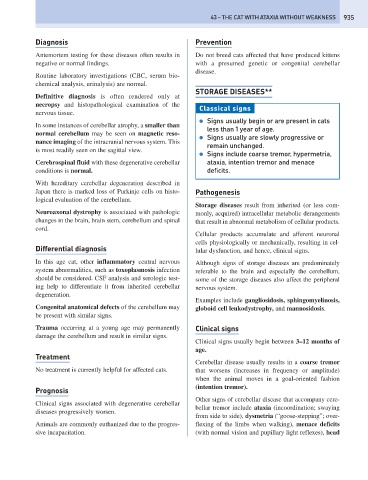Page 943 - Problem-Based Feline Medicine
P. 943
43 – THE CAT WITH ATAXIA WITHOUT WEAKNESS 935
Diagnosis Prevention
Antemortem testing for these diseases often results in Do not breed cats affected that have produced kittens
negative or normal findings. with a presumed genetic or congenital cerebellar
disease.
Routine laboratory investigations (CBC, serum bio-
chemical analysis, urinalysis) are normal.
STORAGE DISEASES**
Definitive diagnosis is often rendered only at
necropsy and histopathological examination of the
Classical signs
nervous tissue.
● Signs usually begin or are present in cats
In some instances of cerebellar atrophy, a smaller than
less than 1 year of age.
normal cerebellum may be seen on magnetic reso-
● Signs usually are slowly progressive or
nance imaging of the intracranial nervous system. This
remain unchanged.
is most readily seen on the sagittal view.
● Signs include coarse tremor, hypermetria,
Cerebrospinal fluid with these degenerative cerebellar ataxia, intention tremor and menace
conditions is normal. deficits.
With hereditary cerebellar degeneration described in
Japan there is marked loss of Purkinje cells on histo- Pathogenesis
logical evaluation of the cerebellum.
Storage diseases result from inherited (or less com-
Neuroaxonal dystrophy is associated with pathologic monly, acquired) intracellular metabolic derangements
changes in the brain, brain stem, cerebellum and spinal that result in abnormal metabolism of cellular products.
cord.
Cellular products accumulate and afferent neuronal
cells physiologically or mechanically, resulting in cel-
Differential diagnosis lular dysfunction, and hence, clinical signs.
In this age cat, other inflammatory central nervous Although signs of storage diseases are predominately
system abnormalities, such as toxoplasmosis infection referable to the brain and especially the cerebellum,
should be considered. CSF analysis and serologic test- some of the storage diseases also affect the peripheral
ing help to differentiate it from inherited cerebellar nervous system.
degeneration.
Examples include gangliosidosis, sphingomyelinosis,
Congenital anatomical defects of the cerebellum may globoid cell leukodystrophy, and mannosidosis.
be present with similar signs.
Trauma occurring at a young age may permanently Clinical signs
damage the cerebellum and result in similar signs.
Clinical signs usually begin between 3–12 months of
age.
Treatment
Cerebellar disease usually results in a coarse tremor
No treatment is currently helpful for affected cats. that worsens (increases in frequency or amplitude)
when the animal moves in a goal-oriented fashion
(intention tremor).
Prognosis
Other signs of cerebellar disease that accompany cere-
Clinical signs associated with degenerative cerebellar
bellar tremor include ataxia (incoordination; swaying
diseases progressively worsen.
from side to side), dysmetria (“goose-stepping”; over-
Animals are commonly euthanized due to the progres- flexing of the limbs when walking), menace deficits
sive incapacitation. (with normal vision and pupillary light reflexes), head

